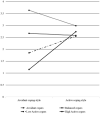Active and avoidant coping profiles in children and their relationship with anxiety and depression during the COVID-19 pandemic
- PMID: 35927558
- PMCID: PMC9352659
- DOI: 10.1038/s41598-022-15793-4
Active and avoidant coping profiles in children and their relationship with anxiety and depression during the COVID-19 pandemic
Abstract
Active and avoidant coping styles are important dispositional factors in the development of anxiety and depression symptoms. Children use both active and avoidant coping strategies together in daily life. No studies have investigated the relationship between active-avoidant coping profiles and internalizing symptoms in children. The present study aimed to investigate children's active-avoidant coping profiles and assess the relationship that active-avoidant coping profiles have with anxiety and depression symptoms. A two-wave longitudinal study was conducted among 322 Chinese children in the People's Republic of China during the COVID-19 pandemic. Participants completed the Children's Coping Strategies Checklist-Revised 1 at Time 1 and the Revised Child Anxiety and Depression Scale at Time 1 and 6 months later (Time 2). Four active-avoidant coping profiles were revealed: low active copers, high active copers, balanced copers, and avoidant copers. Low and high active copers had lower levels of anxiety and depression symptoms than balanced copers and avoidant copers. Avoidant copers showed a larger decrease in depression symptoms than balanced copers and high active copers during the COVID-19 pandemic. It is important to improve children's active-avoidant coping profiles to relieve anxiety and depression symptoms.
© 2022. The Author(s).
Conflict of interest statement
The authors declare no competing interests.
Figures
Similar articles
-
Dealing with the impact of the COVID-19 outbreak: Are some athletes' coping profiles more adaptive than others?Eur J Sport Sci. 2022 Feb;22(2):237-247. doi: 10.1080/17461391.2021.1873422. Epub 2021 Feb 8. Eur J Sport Sci. 2022. PMID: 33410729
-
Hidden in Plain Sight? Men's Coping Patterns and Psychological Distress Before and During the COVID-19 Pandemic.Front Psychiatry. 2022 Jan 5;12:772942. doi: 10.3389/fpsyt.2021.772942. eCollection 2021. Front Psychiatry. 2022. PMID: 35069282 Free PMC article.
-
Left-behind children's social adjustment and relationship with parental coping with children's negative emotions during the COVID-19 pandemic in China.Int J Psychol. 2021 Aug;56(4):512-521. doi: 10.1002/ijop.12754. Epub 2021 Mar 19. Int J Psychol. 2021. PMID: 33739446 Free PMC article.
-
Transactional Associations Between Parent and Late Adolescent Internalizing Symptoms During the COVID-19 Pandemic: The Moderating Role of Avoidant Coping.J Youth Adolesc. 2021 Mar;50(3):459-469. doi: 10.1007/s10964-020-01374-z. Epub 2021 Jan 25. J Youth Adolesc. 2021. PMID: 33495969 Free PMC article.
-
Coping with the mental health impact of COVID-19: A study protocol for a multinational longitudinal study on coping and resilience during the COVID-19 pandemic.PLoS One. 2023 May 18;18(5):e0285803. doi: 10.1371/journal.pone.0285803. eCollection 2023. PLoS One. 2023. PMID: 37200282 Free PMC article.
Cited by
-
Endophenotype 2.0: updated definitions and criteria for endophenotypes of psychiatric disorders, incorporating new technologies and findings.Transl Psychiatry. 2024 Dec 24;14(1):502. doi: 10.1038/s41398-024-03195-1. Transl Psychiatry. 2024. PMID: 39719446 Free PMC article. Review.
-
Evaluation of a multicomponent positive psychology program to prevent gaming disorder and enhance mental wellness in primary pupils: A randomized controlled trial.J Behav Addict. 2024 Sep 30;13(3):871-883. doi: 10.1556/2006.2024.00052. Print 2024 Oct 4. J Behav Addict. 2024. PMID: 39348198 Free PMC article. Clinical Trial.
-
Family history does not influence stress or major coping styles in adults with neurofibromatosis type 1.J Genet Couns. 2025 Jun;34(3):e70052. doi: 10.1002/jgc4.70052. J Genet Couns. 2025. PMID: 40361300 Free PMC article.
-
Mental health and quality of life in children and adolescents during the COVID-19 pandemic: a systematic review of longitudinal studies.Front Public Health. 2024 Jan 8;11:1275917. doi: 10.3389/fpubh.2023.1275917. eCollection 2023. Front Public Health. 2024. PMID: 38259801 Free PMC article.
-
Associations of Psychological Capital, Coping Style and Emotional Intelligence with Self-Rated Health Status of College Students in China During COVID-19 Pandemic.Psychol Res Behav Manag. 2022 Sep 14;15:2587-2597. doi: 10.2147/PRBM.S383743. eCollection 2022. Psychol Res Behav Manag. 2022. PMID: 36133628 Free PMC article.
References
-
- Lazarus RS. Psychological Stress and the Coping Process. McGraw-Hill; 1966.
-
- Boekaerts M. Intensity of emotions, emotional regulation, and goal framing: How are they related to adolescents' choice of coping strategies? Anxiety Stress Coping. 2002;15(4):401–412. doi: 10.1080/1061580021000056546. - DOI
MeSH terms
LinkOut - more resources
Full Text Sources
Medical




